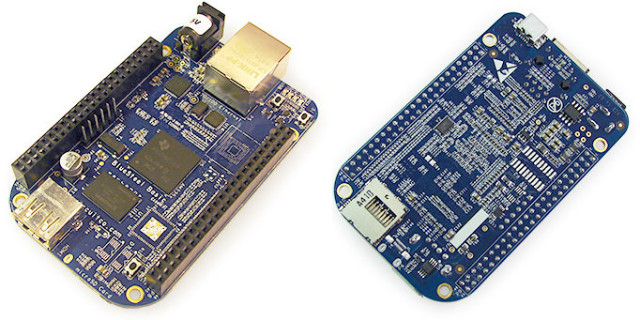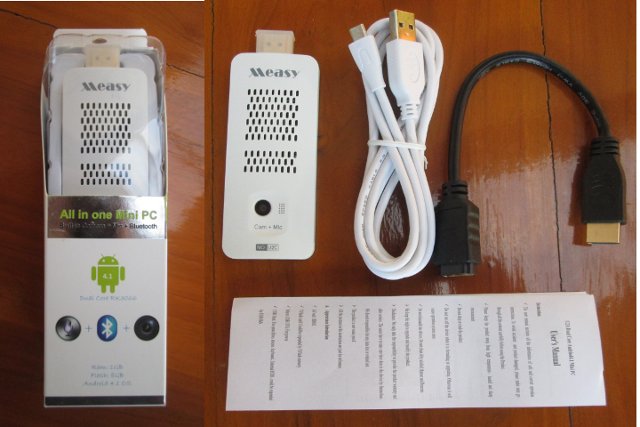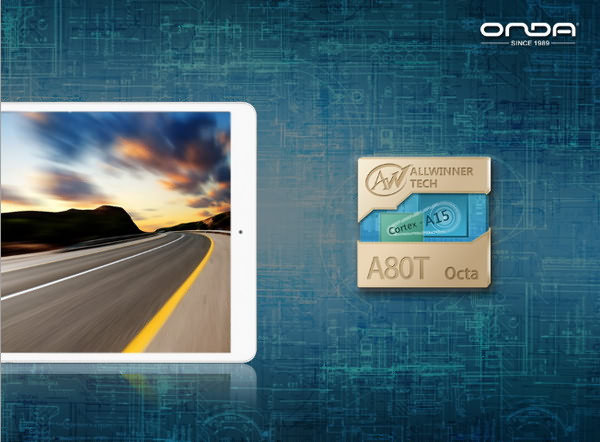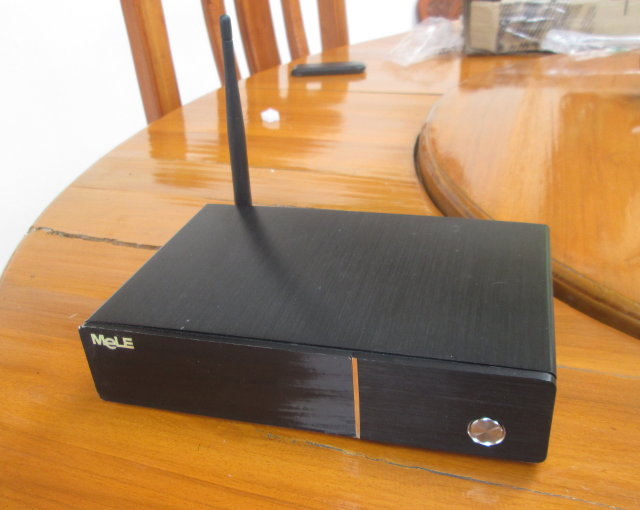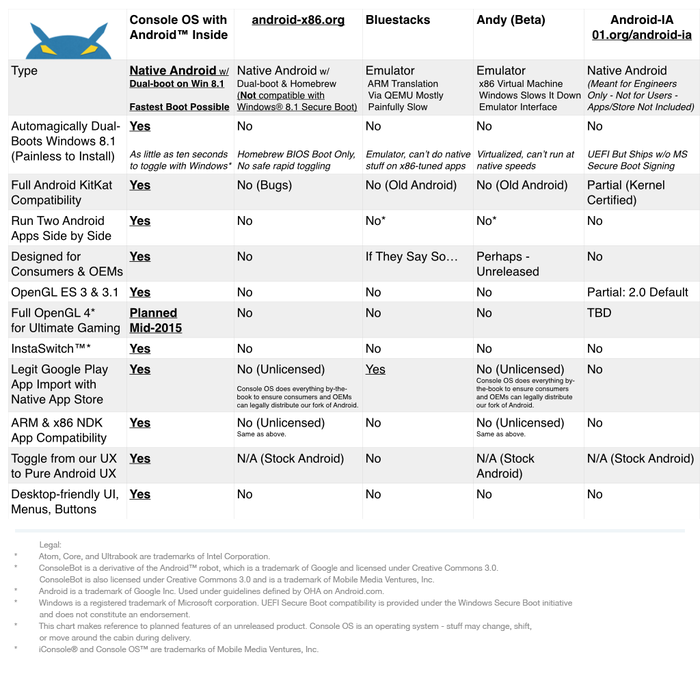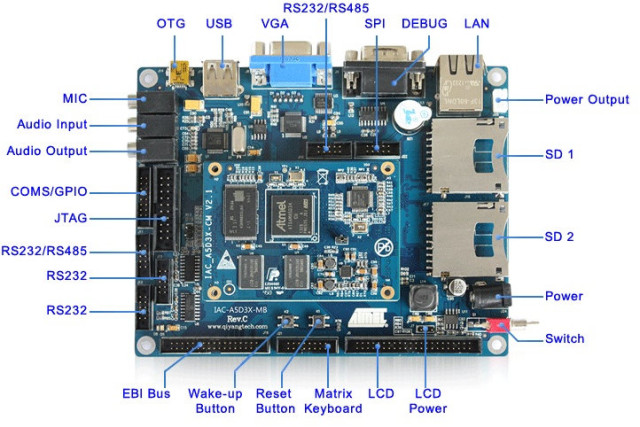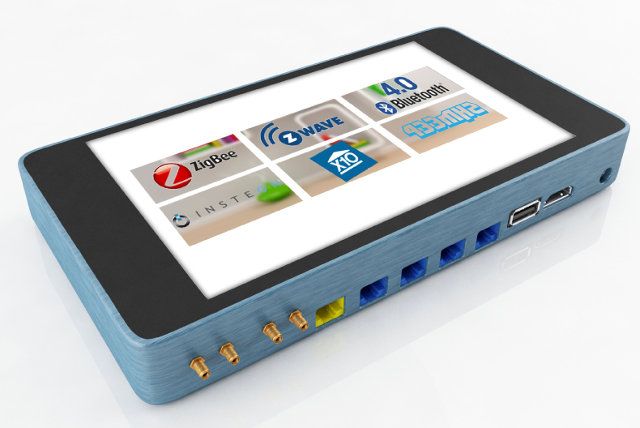CircuitCo has just introduced BlueSteel-Basic, a development board based on the Beaglebone Black but with a Blue PCB, no HDMI output, and no eMMC flash that’s destined to be used by OEMs in their products. LinuxGizmos also reports that BlueSteel-Basic is to be followed by BlueSteel-IT, an industrial temperature grade (-40 to 100°C) board based on the Beaglebone Black, and Bluesteel-Core, a computer-on-module (CoM) based on Ti Sitara AM335x that are scheduled for July 2014. Let’s checkout BlueSteel-Basic specifications: SoC – Texas Instruments Sitara AM3358BZCZ100 @ 1GHz (2000 MIPS) with PowerVR SGX530 3D GPU (20M Polygons/S) System Memory – 512MB DDR3L @ 800MHz Storage – micro SD slot Connectivity – 10/100M Ethernet (RJ45) USB – 1x USB 2.0 host port, 1x mini USB 2.0 port Debugging – Serial header and optional on-board 20-pin CTI JTAG Expansion Connectors Signals: Power 5V, 3.3V, VDD_ADC (1.8V) 3.3V I/O On All Signals McASP0, SPI1, […]
Giveaway Week – Measy U2C Android TV Dongle
Measy U2C, aka B12, will be the prize for day 3 of Giveaway week. It’s an HDMI & AV TV dongle powered by Rockchip RK3066 SoC with 1GB RAM, 8GB flash that happens to feature a 2MP camera for video conferencing as well. It’s running Android 4.1.x Jelly Bean. When I reviewed Measy U2C at the beginning of last year, I had some issues with USB mouse and keyboard support, the firmware could have been more stable, and the Antutu scores seem a bit on the low side, but Wi-Fi and video playback were both very good. It has received one or two firmware update since then, which may have fixed some of the bugs. The last firmware update must have been in April or May 2013, so it has not been a device greatly supported. To enter the draw simply leave a comment below. Other rules are as follows: […]
Onda V989 Tablet Powered by AllWinner A80T Achieves Close to 50,000 Points in Antutu
Teclast T97 was one the first tablet based on AllWinner A80, an octa-core CortexA15/A7 big.little processor with PowerVR G6230 GPU. It was announced way too early last December… There’s now another tablet much closer to an actual retail availability called Onda V989 featuring AllWinner A80T with a 9.7″ display and 2 or 4 GB RAM that come close to the top of the Antutu scoreboard with 48102 points. Unfortunately that’s all we know about this tablet at this stage. I’m not sure what A80T means, AllWinner A80 Tablet version?, or AllWinner A80 Turbo, with higher clock frequencies? There has also been some sort of silly season with benchmark related to AllWinner A80 with scores ranging from 23674 to 48102 points in Antutu as shown below for Onda V989. The low score was achieved when A80’s Cortex A15 cores were allegedly clocked at 1.2GHz , but it should be closer to […]
Giveaway Week – Mele X1000 Blu-Ray Navigation Android TV Box
For day 2 of Giveaway Week, I’ll list Mele X1000, an higher-end Android 4.4 Kitkat TV box with a metallic enclosure, and powered by Telechips TCC8935 dual core Cortex A9 SoC with 1GB RAM, 4GB flash, HDMI and AV outputs, an external SATA connector, Ethernet and Wi-Fi, as well as a few USB ports. The selling point of this box is that it can handle Blu-Ray navigation in XBMC. Since my review of Mele X1000 in March, the company has released new firmware via OTA updates, so the box has certainly improved. At the time of the review I found the hardware build to be of high quality, Wi-Fi performance to be really excellent, that it indeed supported Blu-ray ISO, and provided lots of advanced settings for video playback, but I could notice some unstabilities, XBMC was not pre-installed, SAMBA and NFS were not working, and some videos could not […]
There’s a New MarsBoard A20 ARM Linux Development Board In Town
MarsBoard, a development board based by AllWinner A10 was released last year, soon followed by MarsBoard A20 with a dual core Cortex A7 AllWinner A20 processor. That board is now called the “Old MarsBoard A20” and is replaced by the “New MarsBoard A20” that features a baseboard + computer-on-module design, increases the NAND flash capacity to 8 GB flash, and supports 1GB RAM by default, with an option for 2 GB RAM. Let’s check the specifications of this new development board: SoC – AllWinner A20 ARM Cortex A7 dual core processor @ 1GHz + Mali-400 GPU System Memory – 1GB DDR3 @ 480 MHz by default, up to 2GB DDR3 Storage – 8GB NAND Flash, SATA II interface, and micro SD slot Video I/O HDMI up to 1080p60 VGA Composite output TV-IN (composite IN) LCD connectors for RGB and LVDS interfaces, capacitive touch support Audio I/O – HDMI, Line In/Out, Microphone […]
Console OS Aims to Run Android Alongside Windows on Intel based PCs, Laptops and Tablets (Crowdfunding)
There are already various solutions to run Android on Windows PC powered by Intel processors either going the emulator route, for example with BlueStacks or AndroVM (now Genimotion), or the native route with solutions such as Android-x86. So when I read Console OS, a port of Android capable of running along side of Windows, was looking for funds on Kickstarter to complete the project, I was perplex. But looking into details, it seems Console OS may indeed bring improvements to existing solutions, and Mobile Media Ventures, the company behind the project, released the following table comparing Console OS to other Android ports. If like me you had never heard of Andy Android, here’s the link to the project. Android IA is Intel ports of Android, which currently targets developers. So according to the developers, Console OS makes installing and dual-booting Android on a Windows PC easy, brings full Android Kitkat […]
Qiyang Technology ARM Development Boards Based on Atmel SAMA5D3, TI Sitara AM335x and Freescale i.MX6 SoCs
Hangzhou Qiyang Technology (杭州启扬智能科技有限公司) is a company based in Hangzhou, China, that provides embedded hardware solutions such as low power development boards and computer-on-modules. I’ve recently come across the company, and they have boards for various ARM based SoCs, but I’ve received details about three of their latest industrial development boards powered by Atmel SAMA5D3 Cortex A5 processor, Texas Instruments Sitara AM335x Cortex A8 SoC, and Freescale i.MX6 single and multi-core ARM Cortex A9 SoCs. Let’s have a look. Qiyang QY-A5D3XEK – Atmel SAMA5D3 Development Board The development kit is comprised of a base board (IAC-A5D3X-MB) and a computer-on-module (ICA-A5D3X_CM) with the following hardware specifications: Processor – Atmel SAMA5D3 ARM Cortex A5 @ 536 MHz (Either SAMA5D31, SAMA5D33, SAMA5D34 or SAMA5D35) System Memory – 256 MB DDR2 @ 333 MHz Storage – 256MB NAND flash + 2MB dataflash on CoM, 2x SD card slot on baseboard Video Output – VGA, […]
Soap is a Touchscreen Enabled Router Supporting Gigabit Ethernet and Lots of Wireless Standards (Crowdfunding)
Soap is a strange creature, and I’m not convinced there are that many use cases for such hardware, but I find it interesting that the developers decided to pack a Freescale i.MX6 Solo/Dual or Quad SoC powered Android 4.4 tablet and a router supporting five Gigabit Etherner ports, as well as WiFI 802.11ac, Wi-0Fi 802.11 b/g/n, Zigbee, Z-wave, Bluetooth 4.0 (BLE), Insteon RF, X10, 433Mhz, NFC, and infrared into one and only device which they call an “Intelligent Home Management Hub”. It’s also complete with an HDMI output port so that you can use it as a media player. Let’s go through the specifications for the four version this little monster (Soap Solo, Soap Dual, Soap Quad, and Soap 8.4): SoC Soap Solo – Freescale i.MX6 Solo single ARM Cortex A9 @ 1 GHz with Vivante GC880 3D GPU Soap Dual – Freescale i.MX6 Dual dual ARM Cortex A9 @ […]

